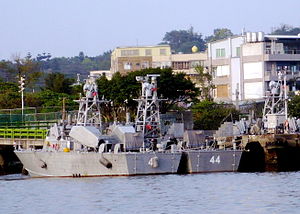| This article relies largely or entirely on a single source. Relevant discussion may be found on the talk page. Please help improve this article by introducing citations to additional sources. Find sources: "Dvora-class fast patrol boat" – news · newspapers · books · scholar · JSTOR (April 2017) |
 Republic of China Navy Dvora-class patrol boat Republic of China Navy Dvora-class patrol boat
| |
| Class overview | |
|---|---|
| Name | Dvora class |
| Builders |
|
| Operators | |
| Preceded by | Dabur class |
| Succeeded by | Super Dvora Mk II class |
| Subclasses | Hau Ou class |
| In commission | 1988 |
| General characteristics | |
| Type | Fast patrol boat |
| Displacement | 45.0 tons full load |
| Length | 21.80 metres (71.5 ft) |
| Beam | 5.50 metres (18.0 ft) |
| Draught | 1.1 metres (3.6 ft) |
| Propulsion | 2 × diesel engines with 4,570 hp (3,410 kW) and two Arneson ASD-16 articulating surface drives. |
| Speed | 37 knots (69 km/h; 43 mph) (max) |
| Range | 560 nmi (1,040 km; 640 mi) |
| Armament |
|
The Dvora-class fast patrol boat is a fast class of patrol boats built by Israel Aerospace Industries for the Israeli Sea Corps based on the Israeli Dabur class.
Operational history
Sri Lanka
The Dvora class has become the work horse of the Sri Lanka Navy which has deployed it since the mid-1980s to counter LTTE operations at sea. Since then Dvoras have been made in Sri Lanka and has been the basis for the more advanced Colombo class fast patrol boat built by the Colombo Dockyard Limited and used by South Asian navies to counter terrorism. According to former Mossad officer Victor Ostrovsky, Amy Yaar, another Mossad operative, helped supply the Sri Lankan government with Dvoras to patrol its coasts from attack by the LTTE. Simultaneously, Yaar and her associates were supplying the Tamils with anti-PT boat equipment to use in fighting the government forces. Ostrovsky also alleged that Mossad helped the Sri Lankan government pay for the boats by cheating the World Bank and other investors out of millions of dollars.
Taiwan
The Republic of China Navy uses Dvoras as Fast Attack Missile Craft, purchasing two and using them as a pattern for the almost-identical, locally-built Hai Ou-class missile boats (Hai Ou class has three propeller shafts whereas Dvora class has two), 50 built. Both classes, being an anti-ship asset, are armed with additional two Hsiung Feng I anti-ship missiles and have been in ROCN service for over 20 years.
Operators
- Israeli Sea Corps - 9 (Initially 10 were in service, 1 decommissioned after collision with a rocky shoal)
- Sri Lanka Navy - 4 (2 acquired in 1984 and 4 in 1986; 3 sunk in 1993, 1995 and 1996).
- Republic of China Navy - 2 original Dvora acquired in the 1980s and 48 local variant version Hai Ou-class (Seagull), retired beginning in 1999 to 2012 (replaced by 30 Kuang Hua VI-class missile boats); originally 26 with 6 gifted to Gambia and Paraguay.
- Four units (ex-ROCN/Taiwan Navy FABG-7, FABG-11, FABG-29 and FABG-32) received from Taiwan in 2009 as patrol gunboats. All 4 were originally slated for Republic of Malawi in 2008.
- Two units (ex-ROCN/Taiwan Navy FABG-1 and FABG-2) received from Taiwan in 1994 as patrol gunboats.
References
- Wirspa, Leslie (1991). "Colombia: Where the guns outrun the mafia". Index on Censorship. 20 (10: Secrecy And Arms: Uncovering The Weapons Trade): 51–52. doi:10.1080/03064229108535240.
- Fish, Tim (March 2009). "Sri Lanka learns to counter Sea Tigers' swarm tactics" (PDF). Jane's Navy International. pp. 20–25. Archived from the original (PDF) on 23 September 2015. Retrieved 22 August 2015.
External links
| Preceded byDabur | Dvora series | Succeeded bySuper Dvora Mk II |
| Israel Aerospace Industries | |
|---|---|
| Products | |
| Subsidiaries | |
| People | |
This article about a specific naval ship or boat is a stub. You can help Misplaced Pages by expanding it. |